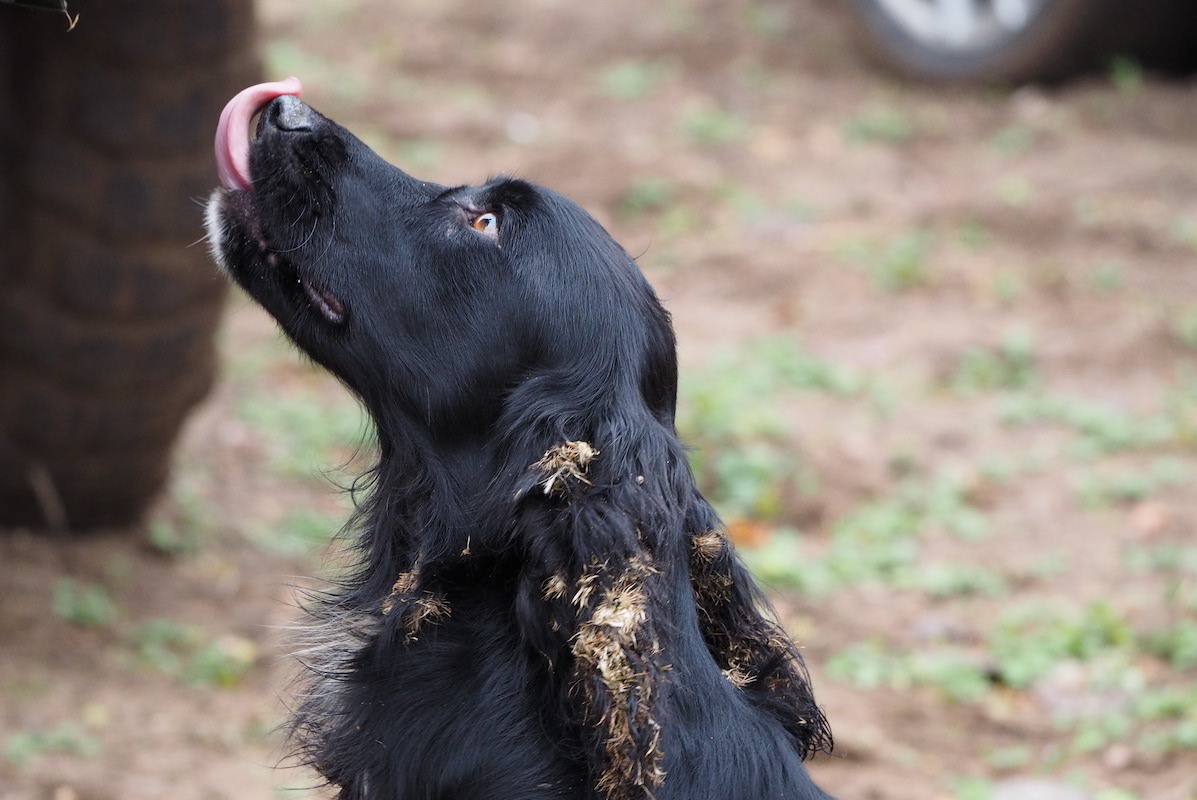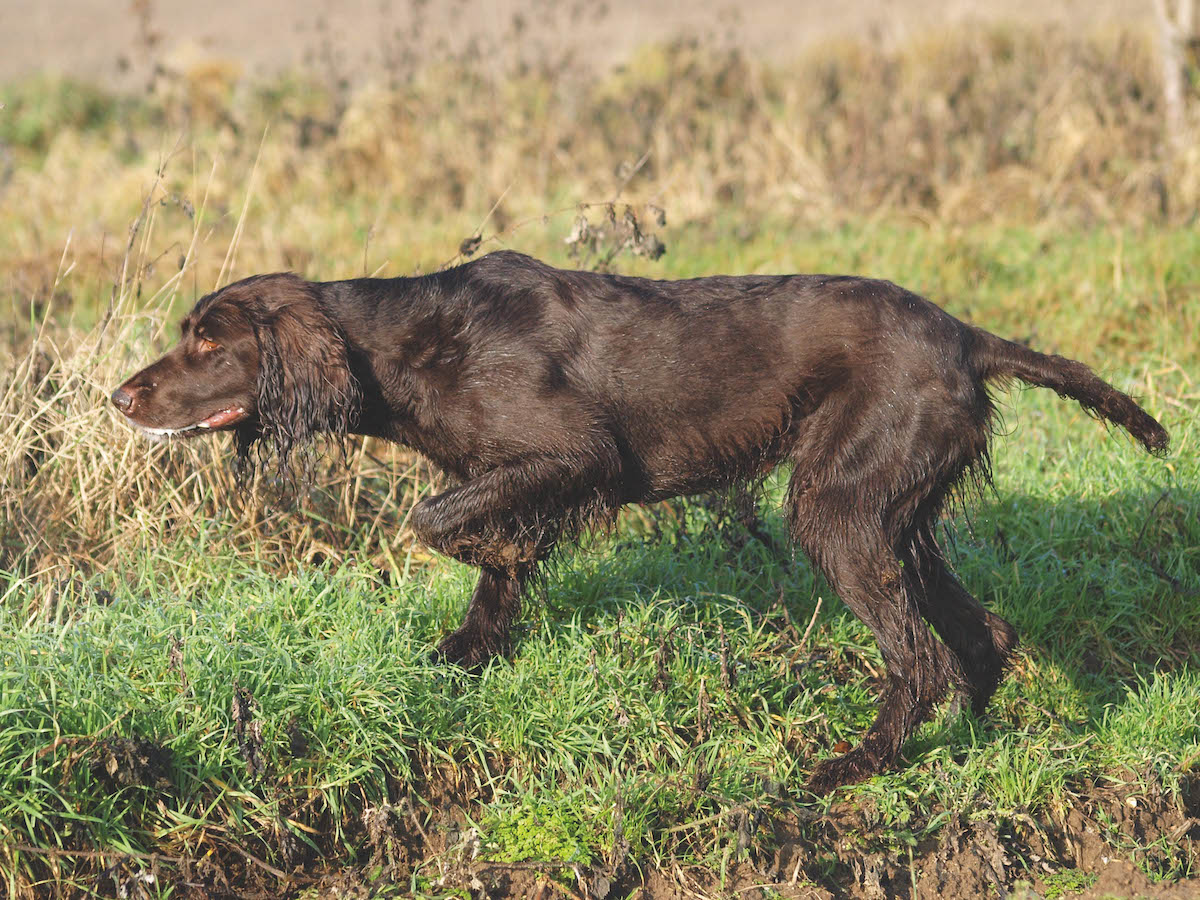Win CENS ProFlex DX5 earplugs worth £1,149 – enter here
Long hair, short hair or wire hair?
 A cocker with burrs from burdock in its ears
A cocker with burrs from burdock in its ears
Most of us have a favourite gundog breed regardless of what sort of coat it has, but the length and nature of a dog’s hair does make quite a difference when it comes to living with the animal, especially if it’s one that lives indoors. It’s certainly something that anyone deciding on a specific breed of dog should think about carefully. There’s no choice of coats with a labrador, except when it comes to colour. However, I’ve met quite a few labradors with remarkably long and wavy coats. (Read more about labradors here.)
There’s no way that these dogs can be called longhaired, but they would be frowned upon in the show ring. According to the breed standard the labrador’s coat is a “distinctive feature, short dense without wave or feathering, giving fairly hard feel to the touch; weather-resistant undercoat”.
The latter is an important feature, for it gives the animal an extra layer of insulation, an important consideration if you are working your dog in harsh conditions, such as wildfowling.
I always chuckle when I see pet labradors being exercised in coats on chilly winter days. These dogs are tough and I don’t think I’ve ever met one that showed any sign of feeling the cold, even when picking-up in deep snow. However, it does make sense for trialling dogs to be rugged-up between runs, especially after hard exercise on a cold day.
Twenty years ago, it was rare to see competition labradors with coats on, but it’s standard practice today. I’ve no doubt that it’s better for the dog’s muscles to be rugged after a run, allowing it to cool more slowly and be ready to run again if asked. (Read should dogs wear coats?)
The only other shorthaired retriever is the Chesapeake Bay. The breed standard insists on a harsh, oily outer coat and a dense, fine, woolly undercoat covering the whole body. Much emphasis is given to the fact that the coat should be water resistant.
These dogs were bred to swim in the icy waters of the eponymous bay, so have the ideal fur to deal with such a challenging environment. Of any of our gundogs, none is better equipped to live in an outdoor kennel than this.
One of the charms of the golden retriever is the long, golden coat, but as any owner of one of these dogs will tell you, it’s a magnet for picking up dirt and debris after a long day in the field. While you can just about get away without brushing a labrador, that’s not the case with a golden, which really needs to be groomed every day.
Cleavers
Spaniels, too, need a regular brush, though I suspect that an awful lot never get the brushing they really require. Their long fur does give them some protection when hunting in dense cover, but there’s nothing like a spaniel’s ears and leg feathers for picking up everything from burrs to cleavers. Though most working strains of cockers and springers aren’t nearly as hairy as their show cousins, keeping their feathers trimmed to a sensible length will save a lot of work after a day’s shooting.
There is also a great deal of variety in the texture of spaniels’ coats. Some are smooth and silky, while others are very woolly. This is particularly common in spayed bitches. Forty years ago I would have never dreamed of having one of my spaniels clipped, but I now have them clipped regularly, especially in the summer when too much fur can lead to overheating. Many owners seem oblivious to this fact, but would you want to walk around in the summer in the same fur coat you wear in winter? (Read should you clip your spaniel in summer?)

German longhaired pointer
Protection
German pointers come in three varieties, shorthaired (GSP), wirehaired (GWP) and longhaired (GLP), though all three are different breeds. While the GSP is a talented all-rounder, the GWP comes into its own when it’s worked in challenging conditions, as its wiry coat really does give it protection from the elements.
The GLP is another proposition entirely and not closely related to the other two. It is the most setter-like of all the HPRs and one of the most stylish. Despite its success in trials, winning the HPR Championship in 2014, the GLP has never caught on in the UK.
Curiously, you can have either a shorthaired or longhaired Weimaraner and they are varieties of the same breed. Long-haired Weimaraners are rare in the UK and I’ve only seen one working here. I’ve seen more in Germany, where they are more numerous.
Though there’s no such thing as a longhaired Hungarian vizsla, there is a choice of smooth-haired or wirehaired. As with the German pointers, these dogs aren’t the same breed. The HWV is a more recent creation, developed in the 1930s. The aim was to produce a dog that had all the attributes of the smooth vizsla, but with a sturdier build and more weather-resistant coat to cope with the harsh Hungarian winters.
According to the HWV breed standard, “the wire coat on the neck and body is harsh and close-fitting, up to 4cm (1½in) long, with an undercoat”. That’s what breeders of these dogs aim for, but I’ve met any with almost smooth coats. Fortunately, it doesn’t seem to affect their ability to work.
Related Articles
Get the latest news delivered direct to your door
Subscribe to Shooting Times & Country
Discover the ultimate companion for field sports enthusiasts with Shooting Times & Country Magazine, the UK’s leading weekly publication that has been at the forefront of shooting culture since 1882. Subscribers gain access to expert tips, comprehensive gear reviews, seasonal advice and a vibrant community of like-minded shooters.
Save on shop price when you subscribe with weekly issues featuring in-depth articles on gundog training, exclusive member offers and access to the digital back issue library. A Shooting Times & Country subscription is more than a magazine, don’t just read about the countryside; immerse yourself in its most authoritative and engaging publication.







